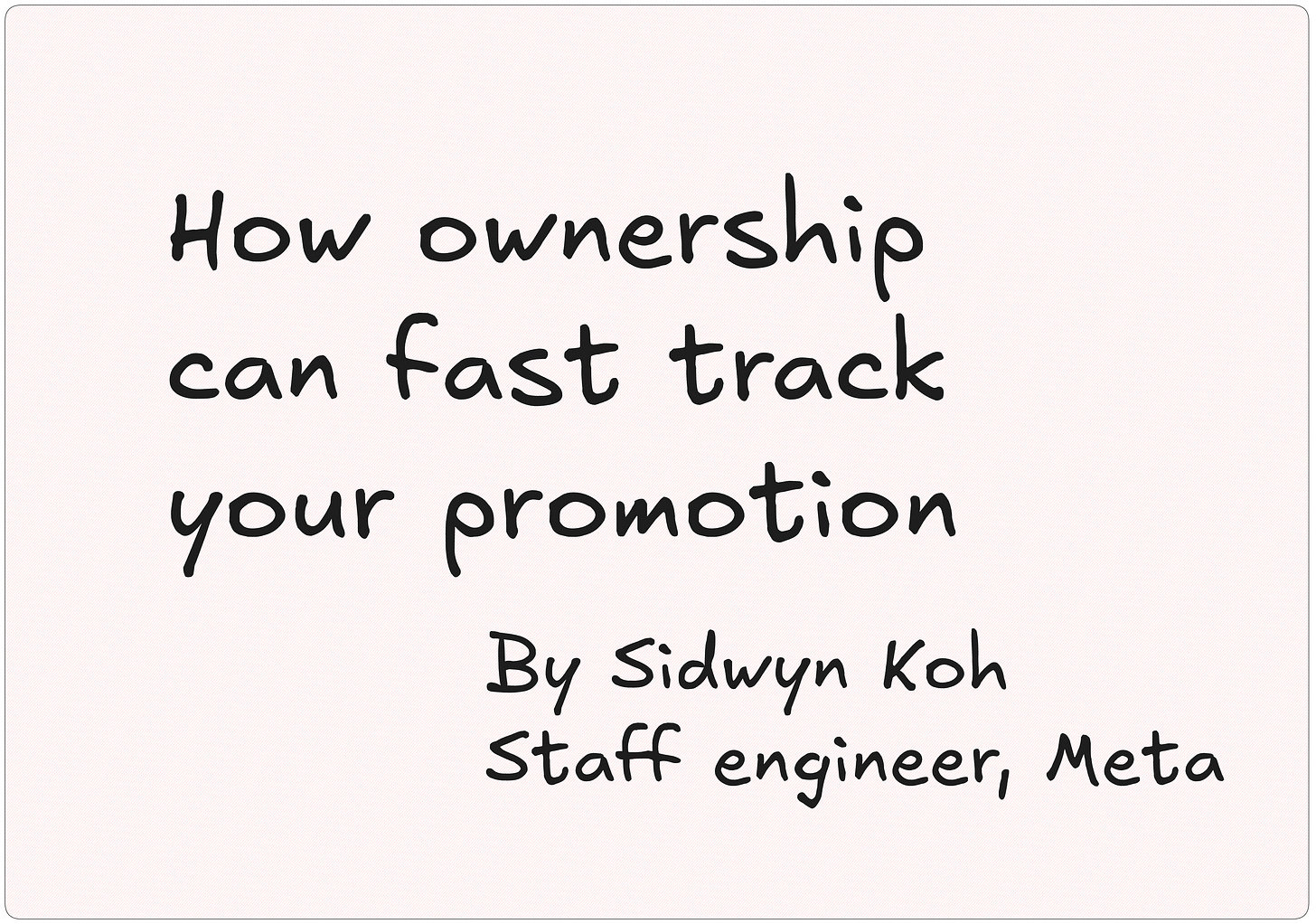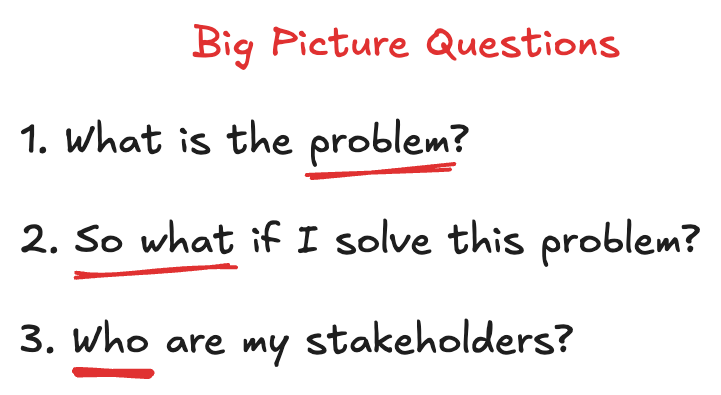How ownership can fast track your promotion (Staff Engineer, Meta)
Hey, Prasad here 👋 I'm the voice behind the weekly newsletter "Big Tech Careers."
This week I bring you a guest post from , staff engineer at Meta and the author of the Path to Staff Engineer newsletter.
In this post, Sidwyn shares what does ownership mean and three step guide to take complete ownership
If you like the article, click the ❤️ icon. That helps me know you enjoy reading my content.
Over to you, Sidwyn!
Ownership
Getting promoted to the Staff levels and beyond is a challenging and sometimes arduous journey. One of the important traits I've seen commonly that helps people fast-track their promotions to Staff+ level is taking complete ownership of the area you are working in. It might be a new strategic initiative or a troubled project that requires you to fix it.
Ownership is not taught explicitly in workplaces, but you pick it up by learning from others. And since ownership has too many moving parts, it looks different in different scenarios. There is no one-size-fits-all formula for ownership, but I'll cover a 3-step guide that will help you navigate how to take ownership.
What is ownership?
Ownership is the behavior of covering a problem end to end. As a problem owner, YOU are in charge of the outcome.
You are the point-of-contact for anything and everything related to this problem. You answer questions or redirect to the right person on your team. You know how bad this problem is and where it's most painful.
Why should I care about ownership?
It is much easier for an organization to track problems by attaching them to owners. This provides clear swimlanes and responsibility.
You'll be recognized for ownership, both within and outside your team. As you communicate your progress, other teams and cross-functional stakeholders will witness your work. These stakeholders are crucial during performance reviews and promotions. They become your advocates when they see you taking complete ownership.
At the end of the day, owning a problem is fun and rewarding. If your journey is successful, you are fast tracking your promotion. Even if there are bumps along the way, there's always something to be learned.
Three Step Guide to Complete Ownership
How does one take ownership? Here are three practical steps from start to finish.
Step 1: Get the big picture
When tasked with a problem, ALWAYS start with the big picture.
What does that mean? Ask these key questions:
After asking these questions, you should:
Understand the problem deeply.
Why does this problem matter to the company and my team?
How urgent is this problem? Are there any external or internal deadlines?
What is this problem costing us today (usually revenue/efficiency). Think about what happens if you DON'T solve the problem.
Know your stakeholders.
Who are the stakeholders of this project?
How do they like to be updated?
How often should I update them?
Understand points of failure.
What could go wrong while trying to solve this problem?
How can we anticipate that ahead of time?
How much buffer do we bake into our plans?
Step 2: Plan before executing
Before you execute, you must have a process in place. Make sure you do the following before you execute:
Build your team and influence
Yes, even if you are an IC, at Staff+ you’ll be getting people together to work on projects. Find people with skills that complement yours.
Work with your manager to approach the people you have in mind and win them over. For me notes like these have worked - "I've heard you are really good at solving problems in this space. Both my manager and I think you'd be a great fit to join us on this journey to solve Problem X. Would you be interested?"
Conduct a brainstorm.
Bring everyone together and have them contribute ideas.
This gives them responsibility and ensures they are bought into the solutions.
I sit everyone down in a room and use a tool like Figjam to conduct a brainstorm. Be open to all new ideas.
Create goals and milestones.
Using these ideas, set achievable goals for the end of the half.
Always underpromise and overdeliver. Remember: you and your team will be held accountable for these goals.
Create smaller milestones for these goals. For example, by the end of the month we'll achieve 5%, in 3 months 15% and by the end of the half we'll be at 30%.
Bonus: Leverage your team specialists to create small, independent goals. This will hold them accountable for their areas.
Hold regular standups:
Standups are the best way to keep your teammates accountable.
Make sure that the agenda is well-structured. My preference is 10 minutes for callouts and 20 minutes for updates.
Use a Kanban board to keep track of tasks so there is visibility throughout the team's progress.
Execute. This one needs no description. You know what to do :)
Step 3: Communicate, communicate, communicate
Communication is extremely important to a project's success. Especially for more urgent projects, it is paramount that you share updates throughout the process.
Find out where your stakeholders congregate.
This could be Slack, email, documents, chats, or internal message boards. Or even a combination of them.
Figure out your cadence sweet spot.
Start a weekly post to keep folks up to date as long as you have enough updates.
You can change this to daily or biweekly, depending on the project's urgency.
Tailor your message to your audience.
Understand your audience well and how much time they have.
Be succinct with your message. I like to use a TLDR up front.
Summarize highlights and lessons learned from the week.
Lean on managers for support.
Your managers will have more meetings than you do and meet more leadership stakeholders.
Lean on your managers to forward your status updates to the right folks. You can use this: "Hey X, I would love your help with increasing the visibility of my project updates. Could you help me forward these weekly status updates to key folks or audiences that I missed? I would really appreciate it.”
Communication is all about ensuring the visibility of your work. Think about it as the marketing side of a startup. You can't always be building without selling.
Real-world example
I'll share a real example that happened several years ago.
I was tasked to build a Tax integration within three months. All I heard was, "We need to integrate with a Large Tax Company before tax filing season starts in January."
It was less than three months, and I had to figure it out. I accepted the challenge.
I made sure I understood the problem end-to-end. I assembled stakeholders, set key goals and milestones. I formed a small but mighty team. We worked hard at the problem, and focused on the problem at hand.
I communicated progress every week on Slack to share key updates. We delivered a week ahead of schedule, and I ended up receiving a promo to senior that year with a "Redefines Expectations" rating. The highest anyone could get at the company.
TLDR
If you want to be promoted to Senior and above, you must take ownership.
Get the big picture: Understand the problem, stakeholders, and potential points of failure.
Plan before executing: Find the right people, brainstorm, and set clear goals.
Communicate, communicate, communicate: The most critical piece to ownership is updating your stakeholders.
I would like to extend a big thank you to
for sharing his insights with Big Tech Careers readers.I also encourage you to check out his newsletter Path to Staff Engineer for more insights on leveling up to the Staff level faster.






